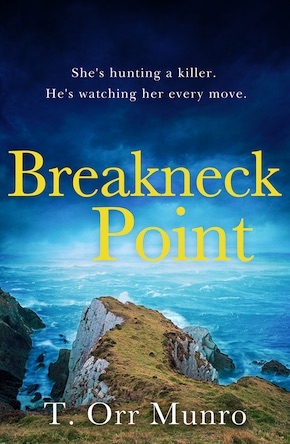Serving up justice
by T. Orr Munro
”’Fresh, vivid and totally engrossing: this is gold-standard crime writing bearing the unmistakable hallmark of authenticity.” Erin Kinsley
An Enid Blyton Secret Seven story about a jewel thief with, in my eight-year-old eyes, the cleverest twist, marked the beginning of my lifelong fascination with crime. So it is probably no surprise that I became a Scenes of Crime Officer with the police, spent over twenty years as a police and crime journalist and now see my first crime novel about a CSI published.
I read a lot of crime and police procedurals, and what is clear is that crime writers work incredibly hard to get the details right, but, even where there is an odd mistake I’m happy to let it slide, because for me the authenticity often lies in a particular character trait or a detective’s relationship with their colleagues or their attitude towards their job – that is what resonates most with me. Here are my all-time favourite sleuths.
I came across Mark Billingham’s DI Tom Thorne series when I picked up a copy of The Killing Habit, a dark story of a psychopath who begins their career by killing pets. DI Thorne’s world-weariness has a real ring of truth about it, but it never diminishes his dogged determination to solve a crime. The best detectives I ever met were those tenacious individuals who simply refused to give up.
The Hieronymus Bosch series by Michael Connelly is another of my favourites. Bosch, an LAPD detective, is as hard-boiled as you’d expect, but what struck me when I first read them was his respectfulness towards innocent murder victims. He never loses sight of the fact he’s dealing with a human being whose life has been snatched away. Bosch’s own mother was murdered and maybe that is the source of his empathy, but I would say that respectfulness is true of most detectives.
I was blown away when I first read Patricia Cornwell’s All That Remains, which is pat of the Kay Scarpetta series. It was the first time I’d read a crime novel where the main protagonist was not only female, but also a scientist. As a SOCO I attended a number of post-mortems, and Cornwell perfectly captures that measured, methodical approach of a pathologist at work.
I loved Kathy Reichs’ Temperance Brennan for the same reason. Brennan is a forensic anthropologist for the medical examiners in Montreal and North Carolina. What I liked about Reichs’ series is the understanding that murder victims deserve justice regardless of when the murder was committed.
No list is complete without Ian Rankin’s Inspector Rebus novels. Brilliantly atmospheric, John Rebus is such a complex character. Weighed down by his past, Rebus encapsulates, for me, that much put-upon detective who feels they would crack cases a whole lot quicker if they were just allowed to do things their way.
I love Ann Cleeves’ Shetland series for the way it captures the challenge of policing tight-knit remote, rural communities, and how a murder has repercussions for the wider community.
As a SOCO I attended a number of post-mortems, and Cornwell perfectly captures that measured, methodical approach of a pathologist at work.”
I was introduced to Val McDermid’s crime-fighting duo DI Tony Hill and psychologist Carol Jordan when I read Cross and Burn. Their relationship had already broken down by then, and what McDermid shows brilliantly is the strain a case puts on those involved and the toll the job takes on them all.
Caz Frear’s Sweet Little Lies centres on a police murder squad in London. It opens with the main character, Cat, suffering the emotional aftershocks of a case, but what I really liked and what felt authentic was the banter within the team, that idle chat between people who spend a lot of time in each other’s company at unearthly hours of the day talking about things entirely unrelated to the case.
P.D. James’ Inspector Adam Dalgliesh series was consistently brilliant. Dalgliesh is one of those police officers who can see right through the lies and deceit. He reminds me of a DI I once worked with – nothing escaped him. He had this ability to get the measure of an individual very quickly, and he was invariably right.
I couldn’t resist including Sir Arthur Conan Doyle’s Sherlock Holmes stories. Holmes isn’t the first detective to use forensics in literature, but he’s the most famous. His understanding that it is the smallest of details that often crack a case is as relevant today as it was then.
 T. Orr Munro trained and worked as a CSI, before changing her career at 33 to become a police and crime journalist. She was born in Hampshire to an English mother and a Greek/Armenian father but later moved to Devon. After university she returned with her family to live in North Devon, the setting for Breakneck Point. Her time as a CSI provided much of the inspiration for the novel, shining a light on what happens behind the crime-scene tape. Breakneck Point is published by HQ in hardback, eBook and audio download.
T. Orr Munro trained and worked as a CSI, before changing her career at 33 to become a police and crime journalist. She was born in Hampshire to an English mother and a Greek/Armenian father but later moved to Devon. After university she returned with her family to live in North Devon, the setting for Breakneck Point. Her time as a CSI provided much of the inspiration for the novel, shining a light on what happens behind the crime-scene tape. Breakneck Point is published by HQ in hardback, eBook and audio download.
Read more
@TinaOrrMunro
t_orr_munro
@HQstories

